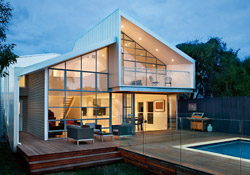|
News
First of a three-part series.
A new generation of tall and complex buildings reflects the latest developments in materials, design, sustainability, construction, and IT technologies. While design complexity can be managed through advances in structural analysis tools and software, ultimately the design of these buildings still relies somewhat on minimum code requirements that are yet to be validated in full scale.
 |
The completed Burj Khalifa.
Photo by nodff / Shutterstock.com |
|
The author developed an extensive survey and real-time Structural Health Monitoring Program (SHMP) to validate the assumptions made during the development of the design and construction planning of the Burj Khalifa tower in Dubai..
At 828 meters, Burj Khalifa is the world's tallest man-made structure, composed of 162 floors above grade and three basement levels. The multi-use tower with a total floor area of 460,000 square meters includes residential, hotel, commercial, office, entertainment, shopping, leisure, and parking facilities. The tower massing is organized around a central core with three wings. Each wing consists of four bays. At every seventh floor, one outer bay peels away as the structure spirals into the sky. The modular Y-shaped building, with a setback at every seventh floor, was part of the original design concept that embodied wind engineering principles and aerodynamic shaping into the architectural design concept to mitigate the dominant dynamic wind effects.
This article is divided into a three part series, the first part (this issue) looks at, 1) the key issues considered in selecting the structural and foundation systems of the tower; 2) a description of the structural and foundation system behaviors of the tower, which are critical to developing the survey and SHMP for the tower; and 3) a description of the real-time SHM and survey programs. The second part will focus on the survey monitoring programs, and the third part will discuss the real time structural health monitoring programs to validate the dynamic response and vibration behavior of the tower, especially under wind and seismic events.
The purpose of the SHMP for Burj Khalifa is to confirm the tower's structural behavior during construction and throughout its lifetime. The program monitors the following:
- Pile load dissipation into the soil
- Raft foundation settlement
- Column shortening at the core wall and exterior columns
- Column/core wall total strains due to gravity load at several levels during construction
- Lateral displacement of the tower during and after construction
- Tower movement and dynamic characteristics during construction at one location
- Tower movement (displacement and acceleration) and dynamic characteristics during the lifetime of the project at seven locations along the height
- Wind speed and profile, temperature variation, and humidity along the height
- Fatigue behavior of the pinnacle
These extensive survey and monitoring programs have, since their inception, provided real time feedback into the actual in-situ material properties, the tower's dynamic characteristics, and structural behavior and response under wind and seismic excitations.
"These extensive survey and monitoring programs have, since their inception, provided real time feedback into the actual in-situ material properties, the tower's dynamic characteristics, and structural behavior and response under wind and seismic excitations."
Structural system
The structural system of the tower was designed to behave like a giant column with a cross sectional shape that reflects the building's massing and profile. Managing the gravity load flow to the building extremities was a significant consideration in the development of the structural concept to overcome the overturning moments caused by extreme lateral loads (wind, seismic, and stability). Most of the tower overturning resistance to lateral loads is managed by the tower's own gravity loads. In addition, managing the column/wall shortening issues (overall and differential) from the early design concept required all columns and walls to be sized to resist gravity loads on an equal stress basis, and tied rigidly by multistory walls at approximately every 21 floors to overcome the differential column shortening issues, which is an important criterion to consider in tall building design and planning.
The tower superstructure of Burj Khalifa is designed as a reinforced concrete building with high performance concrete from the foundation level to level 156, and is topped with a structural steel braced frame from level 156 to the highest point of the tower.
 |
Fig 1
Photo of completed tower and lateral load resisting system. |
|
Lateral load resisting system
The tower's lateral load resisting system consists of ductile core walls linked to the exterior columns through a series of shear wall panels at the mechanical levels (see Figure 1). The core walls vary in thickness from 1,300 millimeters to 500 mm. The core walls are typically linked through a series of 800 to 1,100 mm-deep link beams at every level. Due to the limitation on the link beam depths, ductile composite link beams are provided in certain areas of the core wall system, typically consisting of steel shear plates, or structural steel built-up I-shaped beams, with shear studs embedded in the concrete section. The link beam width typically matches the adjacent core wall thickness.
At the top of the "center" core wall, a very tall spire tops the building. The lateral load resisting system of the spire consists of a diagonal structural steel bracing system from level 156 to the top of the spire at approximately 750 m above ground. The pinnacle consists of a structural steel pipe section varying from 2,100 mm diameter x 60 mm thick at the base to 1,200 mm diameter x 30 mm thick at the top (828 m).
"While the wind behavior of supertall buildings is one of the most important design criteria, gravity load management is also critical as it has direct impact on the overall efficiency and performance of the tower and it should be addressed at the early design stage for integration of the architectural and structural design concepts."
Gravity load management and structural system optimization
While the wind behavior of supertall buildings is one of the most important design criteria, gravity load management is also critical as it has direct impact on the overall efficiency and performance of the tower and it should be addressed at the early design stage for integration of the architectural and structural design concepts. The means and methods of mobilizing and redistributing gravity load can have their own inefficiencies and demands that if not managed properly could result in their own design and construction complexities.
 |
Fig. 2
Lateral load resisting system. |
|
The total material needed to support the tower gravity load and that required to resist the combined effect of gravity and lateral loads is one and the same, which illustrates the efficacy of the structural system. Limiting the center and wing core wall thicknesses allowed the gravity load to flow freely into the center corridor spine web walls to the hammerhead walls and nose columns for maximum resistance to lateral loads (see Figure 2). Along these load flow lines and vertical columns, strain gages are installed to track the gravity load flow and to measure the column shortening.
Floor framing system
The residential and hotel floor framing system of the tower consists of a 200 to 300 mm two-way reinforced concrete flat plate spanning approximately 9 m between the exterior columns and the interior core wall, which were modified during construction to a flat plate system with 50 mm taper at the walls. The floor framing system at the tips of the tower floor consists of a 225 to 250 mm two-way reinforced concrete flat slab system with 150 mm drop panels.
 |
Fig. 3
Tower raft foundation plan and photo of raft construction. |
|
Foundation system
The tower is founded on a 3,700 mm-thick high performance reinforced concrete raft supported by 1,500 mm-diameter bored piles, extending approximately 45 m below the base of the raft. All piles utilize high performance self-compacting concrete with w/c ratio not exceeding 0.30, placed in one continuous concrete pour using the tremie method. The reinforced concrete raft is placed over a minimum 100 mm blinding slab over waterproofing membrane, over at least 50 mm blinding slab. The raft foundation bottom and all sides are protected with waterproofing membrane. See Figure 3 for the raft foundation plan and raft construction. In addition, the installation of cathodic protection for the tower foundation system ensures its longevity against corrosive effects of soil and water that have high levels of chloride and sulphite.
Wind engineering management
Wind engineering is one of the primary concerns in planning the design of tall buildings. The shape of the Burj Khalifa project is the result of collaboration between SOM's architects and structural engineers. Several wind engineering techniques were employed in the design of the tower to control the dynamic response of the tower under wind loading by disorganizing vortex shedding formation (frequency and direction) along the building height and tuning the dynamic characteristics of the building to improve its dynamic behavior and to prevent lock-in vibration. The wind engineering management of the tower was achieved by:
- Varying the building shape along the height while continuing and without interrupting the building gravity and lateral load resisting system
- Reducing the floor plan along the height, effectively tapering the building profile
- Using the building shapes to introduce spoiler-type effects along the entire height of the tower, including the pinnacle, to reduce the dynamic wind excitations
- Changing the orientation of the tower, along its stiffest direction, in response to the most severe wind direction
- Tuning the building natural frequencies and mode shapes to optimize the building dynamic response against wind excitations, including maximizing the tower's generalized mass.
Early conceptual sketches were developed to demonstrate the significance of varying the building shape along its height to minimize the wind forces on the tower. The variation of the tower shape and width have resulted in wind vortices around the perimeter of the tower, which occurred differently at different shapes with different frequencies, thus disorganizing the interaction of the tower structure with the wind. Extensive wind tunnel studies and testing regimes were established to confirm these favorable wind engineering management strategies.
Structural health monitoring system description
Constructing the Burj Khalifa to a degree of accuracy similar or better than that attained in steel construction required the implementation of a state-of-the art survey and structural health monitoring program which included:
- Extensive survey monitoring program to measure the foundation settlement, column shortening, and lateral building movement during construction
- Installation of strain gages to measure the total strains at the main structural members, including piles, raft foundation, walls, columns, and outrigger shear wall panels
- Installation of a temporary real-time health monitoring program to measure the building lateral displacement and acceleration during construction, and to identify the building dynamic characteristics (frequencies, damping, etc.) during construction. This system included bi-directional accelerometers, GPS system, and weather station (wind speed, wind direction, humidity, and temperature)
- Installation of a permanent real-time structural health monitoring program to measure the building motions (acceleration, displacement) due to lateral loads (wind, and seismic in particular), and any other unexpected lateral loads. In addition to the installation of a GPS system, bi-directional accelerometers and sonimometers were installed at several levels along the building height to provide real-time building accelerations and wind data. The installation of these devices in essence resulted in 1) the development of a full scale aeroelastic model of the tower while providing full feedback and details on the dynamic characteristics of the tower; 2) sufficient data to assess the fatigue behavior of the steel structure in general and at the pinnacle in particular; 3) wind speed and distribution along the building height; and 4) real-time information on the building movements and characteristics to allow the building facility and management team to make management decisions about any issues that may arise during the tower's lifetime.
Ahmad Abdelrazaq, MS, is the senior executive vice president, head of Highrise & Complex Building Division, Samsung C&T Corporation. He previously worked at SOM. Contact him ata.abdelrazaq@samsung.com.
|







